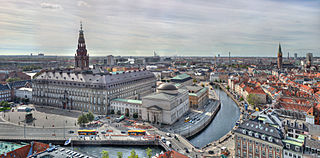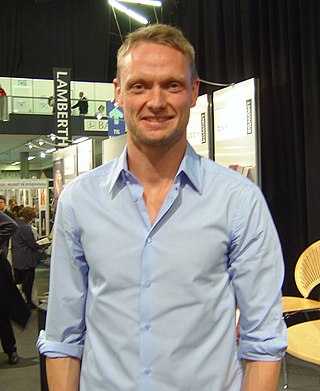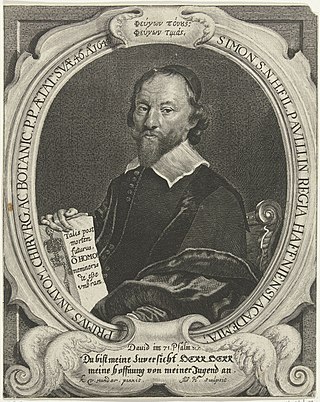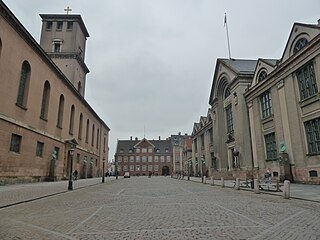Related Research Articles

Copenhagen is the capital and most populous city of Denmark, with a population of around 1.4 million in the urban area, and more than 2 million in the wider Copenhagen metropolitan area. The city is on the islands of Zealand and Amager, separated from Malmö, Sweden, by the Øresund strait. The Øresund Bridge connects the two cities by rail and road.

Arne Emil Jacobsen, Hon. FAIA 11 February 1902 – 24 March 1971) was a Danish architect and furniture designer. He is remembered for his contribution to architectural functionalism and for the worldwide success he enjoyed with simple well-designed chairs.
The culture of Denmark has a rich scientific and artistic heritage. The astronomical discoveries of Tycho Brahe (1546–1601), Ludwig A. Colding's (1815–1888) neglected articulation of the principle of conservation of energy, and the foundational contributions to atomic physics of Niels Bohr (1885–1962); in this century Lene Vestergaard Hau in quantum physics involving the stopping of light, advances in nano-technology, and contributions to the understanding of Bose-Einstein Condensates, demonstrate the range and endurance of Danish scientific achievement. The fairy tales of Hans Christian Andersen (1805–1875), the philosophical essays of Søren Kierkegaard (1813–1855), the short stories of Karen Blixen, penname Isak Dinesen, (1885–1962), the plays of Ludvig Holberg (1684–1754), modern authors such as Herman Bang and Nobel laureate Henrik Pontoppidan and the dense, aphoristic poetry of Piet Hein (1905–1996), have earned international recognition, as have the symphonies of Carl Nielsen (1865–1931). From the mid-1990s, Danish films have attracted international attention, especially those associated with Dogme 95 like those of Lars Von Trier. Denmark has had a strong tradition of movie making and Carl Theodor Dreyer has been recognised as one of the world's greatest film directors.

Christine Jorgensen was an American trans woman who was the first person to become widely known in the United States for having sex reassignment surgery. She had a successful career as an actress, singer, and recording artist.

Copenhagen Business School often abbreviated and referred to as CBS, is a public university situated in Copenhagen, Denmark and is considered one of the most prestigious business schools in Western Europe and the world.

Kenneth Carlsen is a Danish former professional tennis player, who was active between 1992 and 2007. Carlsen played left-handed with a one-handed backhand. His greatest asset was his powerful serve, and his game was therefore best suited to fast surfaces. For most of his long career, Carlsen was Denmark's best tennis player, and consistently among the few Danish players playing at the highest international level. He was awarded as best Danish "Tennis Player of the Year" seven times by the Danish Tennis Federation. Two times the award went to the Danish Davis Cup team, of which Kenneth Carlsen until 2003 was a central part.

An anatomical theatre was a specialised building or room, resembling a theatre, used in teaching anatomy at early modern universities. They were typically constructed with a tiered structure surrounding a central table, allowing a larger audience to see the dissection of cadavers more closely than would have been possible in a non-specialized setting.

The Anatomical Theatre of the Archiginnasio is a hall once used for anatomy lectures and displays held at the medical school in Bologna, Italy that used to be located in the Palace of the Archiginnasio, the first unified seat of the University of Bologna. A first anatomical theatre was constructed in 1595, in a different location, but it was replaced by a bigger one built in 1637 in the current location, following the design of the architect Antonio Levanti. The ceiling and the wall decoration were completed from 1647 to 1649 but only the lacunar ceiling dates from this period, with the figure of Apollo, the god of Medicine, in the middle, surrounded by symbolic images of constellations carved in wood.

Arkitektfirmaet C. F. Møller, internationally also known as C. F. Møller Architects, is an architectural firm based in Århus, Denmark. Founded in 1924 by C. F. Møller, it is today the largest architectural firm in Denmark based on number of employed architects. About half the revenue is earned outside Denmark. Besides the main office in Århus, the firm has offices in Copenhagen, Oslo, London and in 2007 it bought the Stockholm-based Swedish architectural practice Berg Arkitekter which is still operated under its own name.

3XN is a Danish architectural practice with head office in Copenhagen.
Events from the year 1736 in Denmark.
Events from the year 1785 in Denmark.

Simon Paulli, was a Danish physician and naturalist. He was a professor of anatomy, surgery and botany at the University of Copenhagen. The genus Paullinia is named after him.

Frederiksberg Allé is a tree-lined avenue which runs through the southernmost part of the Frederiksberg district of Copenhagen, Denmark. It connects Vesterbrogade at Værnedamsvej to Frederiksberg Runddel in front of the main entrance to Frederiksberg Gardens. It was originally constructed in 1704 as the king's private road leading to his new summer residence, Frederiksberg Palace. It developed into the backbone of an entertainment district in the mid 18th century, and has continued to be associated with theatres until the present day. The avenue is lined with two double rows of linden trees and bisects Sankt Thomas Plads, a small round plaza, shortly after its departure from Vesterbrogade.
The Royal Danish Academy of Surgery, or Academia Chirurgorum Regia, was an educational institution which existed from 1785 until 1842 in Copenhagen, Denmark. Its former building at Bredgade now houses Medical Museion, University of Copenhagen's museum of medicine.

Domus Anatomica was an anatomical theatre which existed from 1644 until 1728 in Copenhagen, Denmark.
Events from the year 1657 in Denmark.
Events from the year 1681 in Denmark.

Frue Plads is a public square located on the north side of the Church of Our Lady in central Copenhagen, Denmark. It occupies a rectangular space which is bounded on the other sides by University of Copenhagen's main building to the north, Nørregade to the west and pedestrianized Fiolstræde to the east.